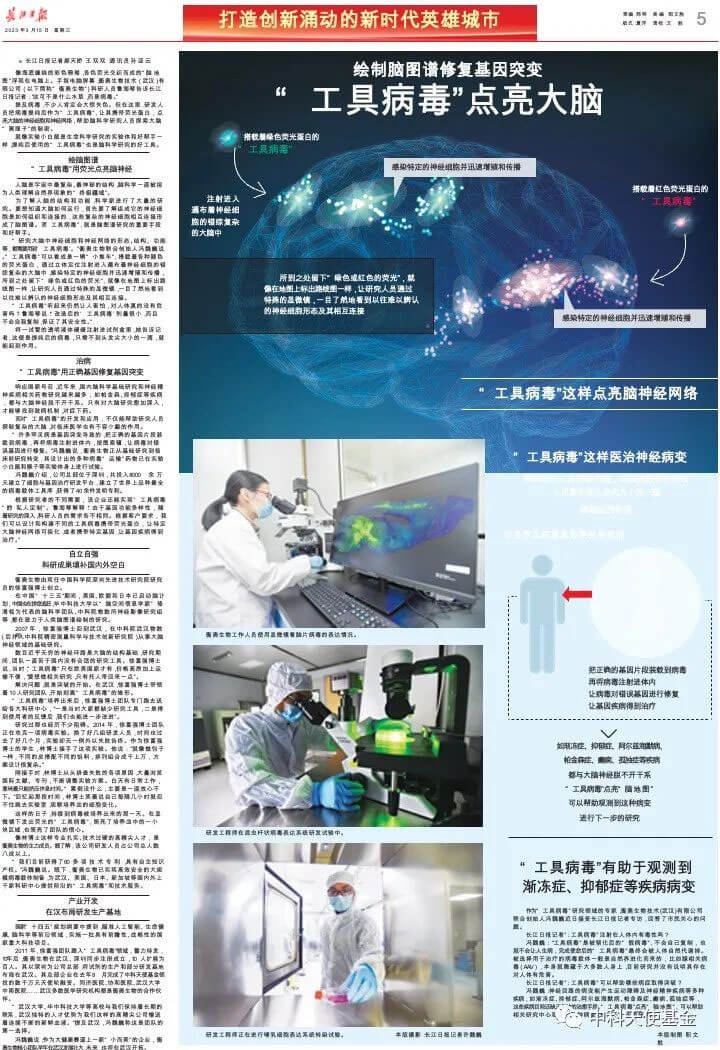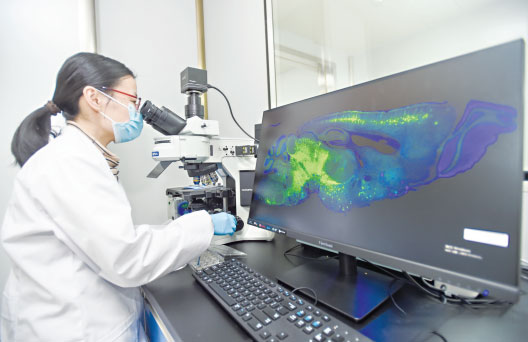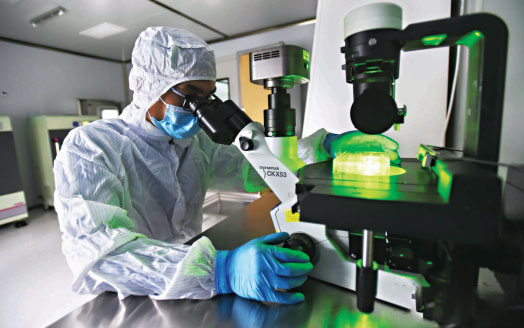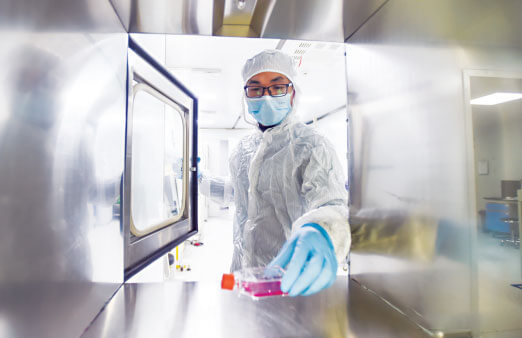- E-mail:support@braincase.cn
- Tel:18971216876
Recently, Wuhan Ayao Biotechnology, a wholly-owned subsidiary of Brinkes, received a full-page report in the "Changjiang Daily", detailing the application of the company's product "tool virus" in brain research.

Like the colorful corals entwined on the seabed, a "brain map" composed of various fluorescent colors appears on the computer. Pointing his finger at the computer screen, Lu Haiqin, a scientific researcher at Ya'ao Biotechnology (Wuhan) Co., Ltd. (hereinafter referred to as "Jia'ao Bio"), told the Changjiang Daily reporter: "This is not a waterweed, but a virus." When it comes to viruses, many People will definitely be shocked. But here, researchers purified the virus and used it as a "tool virus" to carry fluorescent proteins to light up the brain's nerve cells and neural networks, helping brain science researchers explore the secrets of the brain's "black box". Just as experimental mice are experimental subjects and good helpers in life science research, purified " tool viruses " are also good tools in brain science research.

Aiao Biology staff used a microscope to look at the expression of viruses in brain slices. Photography: Changjiang Daily reporter Xu Weiwei
The human brain is the most complex and mysterious structure in the universe, and brain science has always been regarded as the "ultimate territory" for humans to understand natural phenomena. In order to understand the structure and function of the human brain, scientists have conducted a large number of studies. To understand how the brain works, we must first understand how the nerve cells that make up it are organized and connected. These complex nerve cells are interconnected to form a brain map. The "tool virus" is an important means and good helper in brain mapping research. "Studying the morphology, structure, and function of nerve cells and neural networks in the brain requires the use of 'tool viruses.'" said Feng Weiwei, co-founder of Aiao Biotechnology. The "tool virus" can be seen as a "cart" carrying fluorescent proteins of various colors. It enters the intricate brain filled with nerve cells through stereotaxic injection, infects specific nerve cells and rapidly proliferates and spreads. , leaving "green or red fluorescence" wherever it goes, just like marking a road map on a map, allowing researchers to see at a glance the morphology of nerve cells and their interconnections that were previously difficult to identify through a special microscope.
"Tool virus" still sounds scary, but is it really not harmful to the human body? Lu Haiqin said: "The dose of the modified 'tool virus' is very small, and it will not replicate itself, ensuring its safety."
She slowly injected a test tube of transparent liquid into the kit. She told reporters that this It is a purified virus that only requires a drop less than the size of a hair tip to be effective.

R&D engineers conduct research and development experiments on insect baculovirus expression systems. Photography: Changjiang Daily reporter Xu Weiwei
In response to the national call, in recent years, there has been an increasing amount of domestic basic research on brain science and drug research related to neuropsychiatric diseases. Diseases such as Parkinson's disease and depression are inseparable from the brain nerves. Only by studying the brain more deeply can we find the pathogenic mechanism and prescribe the right medicine.
The development and application of "tool viruses" can not only help researchers explore the complex brain, but also play an important role in clinical medicine. "Many rare diseases are caused by genetic mutations. Load the correct gene fragment into the virus, then inject the virus into the body, follow the diagram, and let the virus repair the wrong gene." Feng Weiwei said that Aiao Biotechnology is moving from basic research to clinical practice Current research has changed, and a variety of virus "transport" drugs designed by it have been tested on experimental subjects such as experimental mice and monkeys.
Feng Weiwei introduced that the company is headquartered in Shenzhen and has invested a total of more than 80 million yuan to establish a cell and gene therapy research and development platform , established the world's most comprehensive viral vector tool library , and obtained more than 40 invention patents .
According to the different needs of researchers, the company can also achieve "private customization" of "tool viruses". Lu Haiqin explained: "Due to the diversity of gene functions, as research deepens, the needs of scientific researchers vary. According to customer requirements, we can design and build different tools. Viruses carry fluorescent proteins to visualize specific brain neural networks. Or carry specific genes so that genetic diseases can be treated.”

R&D engineers are conducting transfection experiments with mammalian cell expression systems. Photography: Changjiang Daily reporter Xu Weiwei
Ayao Biotech was founded by Dr. Xu Fuqiang , who is currently a researcher at the Shenzhen Institute of Advanced Technology, Chinese Academy of Sciences .
During China's "Thirteenth Five-Year Plan" period, the United States, the European Union and Japan have launched brain projects, and China is also desperately catching up. The brain science team of Huazhong University of Science and Technology represented by "brain spatial informatics scientist" Luo Qingming, the Institute of Physics and Mathematics of the Chinese Academy of Sciences, and the Neuroimaging Research groups and others are working on the study of human brain mapping.
In 2007, Dr. Xu Fuqiang returned to Wuhan and engaged in basic research in the field of brain nerves at the Wuhan Institute of Physics and Mathematics, Chinese Academy of Sciences (later merged into the Institute of Precision Measurement Science and Technology Innovation, Chinese Academy of Sciences).
The nearly infinite number of neural circuits is the structural basis of the brain. During the research, the team has been suffering from the lack of suitable research tools in China. Dr. Xu Fuqiang said that at that time, "tool viruses" were only available in European and American countries. The price was high and transportation was inconvenient. "If you want to do relevant research, you can only ask someone to bring some back."
Solving the problem is the beginning of breakthrough. In Wuhan, Dr. Xu Fuqiang led a research team of 10 people and began to characterize the prototype of the "tool virus".
After the "tool virus" was cultivated, Dr. Xu Fuqiang's team specially sent it to major scientific research centers. "First, everyone lacked research tools at the time. Second, after receiving feedback from users, we can further improve it."
The research process also encountered many obstacles. In 2014, Dr. Xu Fuqiang’s team was conquering a virus experiment. Several groups of R&D personnel were changed, and several months passed, but the experiments ended in failure without exception. As a student of Dr. Xu Fuqiang, Dr. Lin took over this experiment. He said: "It's just like making steamed buns. Different skins are matched with different fillings. There are thousands of permutations and combinations. The design is very complicated." When he first took over, Dr. Lin investigated the reasons for failure from scratch and
browsed a large number of international literature. , special issue, and constantly adjust the experimental plan. Having a daily routine during the day means you can only squeeze in your rest time. "It's nothing to be tired. The main thing is that I feel uneasy all the time." Recalling that period, Dr. Lin smiled and said that he couldn't help but run to the laboratory every few hours to observe the changes in cells in the culture dishes.
Days like this last until the day the virus is cultured. The "tool virus" that fluoresced under the microscope illuminated a small area in the petri dish and also illuminated the team's confidence.
High-end talents with solid professional skills and excellent skills like Dr. Lin are the main members of Aiao Bio. It is understood that the company's R&D personnel account for more than 80% of the company's total number of employees .
"We have currently obtained more than 60 technology patents and have independent intellectual property rights." Feng Weiwei said. At present, Ayao Biotechnology has achieved efficient and safe large-scale viral vector preparation, providing cutting-edge "tool viruses" and technical services to thousands of domestic and foreign scientific research centers in Wuhan, the United States, Japan, and Singapore.
The outline of the country's "14th Five-Year Plan" mentions that targeting cutting-edge fields such as artificial intelligence, life and health, and brain science, we will implement a number of forward-looking and strategic national major science and technology projects.
In 2011, Xu Fuqiang's team entered the field of "tool viruses" and was ready to go. Ten years later, Aiao Biotech was simultaneously registered in Wuhan and Shenzhen, and its 10 people expanded to 100 people. It uses Shenzhen as its company headquarters, and its reagent production and part of its R&D base are located in Wuhan . Its headquarters company completed tens of millions of yuan in angel round financing led by Zhongke Angel Fund in August last year. Tongji Hospital, Union Hospital, Zhongnan Hospital of Wuhan University...most medical research institutions in Wuhan are partners of Aio Biotech.
"Wuhan University, Huazhong University of Science and Technology and other universities have maintained long-term contacts with us. Wuhan's unique talent advantages provide continuous fresh blood to high-tech companies like ours." When it comes to Wuhan, Feng Weiwei said that this is the team's first choice.
Feng Weiwei said that as a "small but beautiful" company on the big health track, the core team of Aiao Biotechnology has grown in Wuhan in the early years and will also develop in Wuhan in the future.
As an expert in the field of "tool virus" research, Feng Weiwei, co-founder of Aia Biotechnology (Wuhan) Co., Ltd., recently accepted an exclusive interview with a reporter from Changjiang Daily and answered questions of public concern.
Changjiang Daily reporter: Is the "tool virus" toxic when injected into the human body?
Feng Weiwei: "Tool viruses" are domesticated "fake viruses" that will not replicate on their own and will not make people sick. After completing their mission, the "tool viruses" will eventually be naturally metabolized by the human body. Viral vectors selected for treatment are generally evolved in nature, such as adeno-associated virus (AAV), which itself is hidden in most people. Current research does not indicate that its existence is harmful to the human body.
Changjiang Daily reporter: What diseases can "tool viruses" help achieve breakthroughs?
Feng Weiwei: Neural circuit lesions can cause movement disorders and neuropsychiatric diseases and other diseases, such as ALS, depression, Alzheimer's disease, Parkinson's disease, epilepsy, autism, etc. There is currently a lack of effective treatments for these diseases. means of healing. The "tool virus" lights up the "brain map" and can help relevant research centers observe this disease and conduct further research.
Source: Changjiang Daily
Reporter: Hao Tianjiao and Wang Shuangshuang